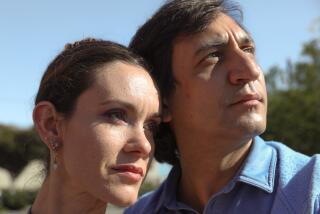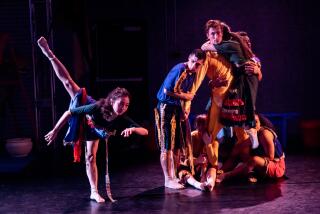The dancing never stops -- it just slows down a little
- Share via
It’s 10 p.m. on a Friday, and while most Angelenos are winding down from a hectic work week, Adriana Gainey is in her fourth hour of dance rehearsals. She shows few signs of fatigue, despite having spent the day teaching the three Rs to third-graders, then tending to her ill 3-year-old son before coming to the Dance Arts Academy in Los Angeles and strapping on flamenco shoes. Gainey also happens to be 5 1/2 months pregnant.
Being pregnant isn’t what it used to be for the physically active. Just 20 years ago, the American College of Obstetricians and Gynecologists cautioned women not to let their heart rates rise above 140 beats per minute, which for some is barely breaking a sweat. (The organization has since revised its guidelines.)
In the 21st century, athletically inclined women know that exercise doesn’t have to end when gestation begins, although some still aren’t sure of their limits.
Olympic and professional athletes may stop competing while pregnant, but many keep up their fitness regimens -- modified, of course -- and resume training about six weeks after giving birth. WNBA player Astou Ndiaye-Diatta, Olympic track and field medalist Marion Jones and Olympic bobsled medalist Vonetta Flowers are just a few who have given birth in recent years and returned to competition soon after.
Gainey, who is the founder and executive director of the 12-year-old Pacifico Dance Company, an L.A.-based Mexican folkloric troupe, still oversees the company’s 14 hours of rehearsal a week, but isn’t running at full speed these days.
This evening started at 6:30 with Gainey leading about 20 dancers in a warm-up that included yoga, stretching, ballet steps and jumps and flamenco work. At 7:30, she took an hourlong modern dance class with the company. Then she led more than two hours of rehearsals.
Although Gainey, a full-time teacher at Kester Avenue Elementary School in Van Nuys, doesn’t perform now that she’s pregnant, classes and rehearsals aren’t exactly effortless for her. She frequently demonstrates moves, everything from a downward-facing dog yoga pose to a complicated flamenco step. The latter requires rhythmic stomping on a hardwood floor while wearing flamenco shoes -- heeled shoes with tiny nails driven into the toes and heels.
“For the most part, I feel great,” says the petite 40-year-old, who looks years younger. As she relaxes in the dance studio’s waiting room before rehearsal begins, she says fatigue is her biggest enemy. Sometimes she feels strong enough to fight it and keep going, while other times the exhaustion is too powerful, and a nap wins out. “I love to exercise and I love to dance, and if I don’t do it, I don’t feel good,” she says. “But I’m trying to listen to my body.”
She never turns down offers of help from members of the company and her husband, who readily volunteers to schlep props and costumes to and from shows. The dancers make sure she has enough water. Gainey also wears a maternity belt, which she places under her leotard and black drawstring stretch pants for support. “Without that, I can really feel the weight of the baby pulling down,” she says, especially during the flamenco steps. “This kind of dancing is hard on the body.”
In a high-ceilinged studio, Gainey stands in front of a mirrored wall and watches as her dancers rehearse for an upcoming show. Men and women sweep across the floor, arms making graceful arcs in the air. When the company does the staccato flamenco routines with flawless precision, the sound is deafening.
Gainey tries to make the dancers understand the subtle tempo difference in a certain step pattern, and she does it again and again until they get it. “It’s like this,” she says, her feet moving impossibly fast.
Yoga has greatly benefited her during both pregnancies, says Gainey, who started practicing hatha yoga a year before her son was born. She was drawn to it because of chronic back and neck pain that doctors wanted to treat with surgery or medication. She takes a yoga class once or twice a week and credits it for not only alleviating her pain but also maintaining her upper-body strength and overall endurance. With five years of yoga behind her, she says she feels stronger and healthier during this pregnancy than during the last.
She’s frustrated, however, at not being able to find her center of gravity as her stomach expands, an essential component of dance. During the modern dance class, Gainey wobbles while attempting to balance on one leg.
During her fifth month of pregnancy with her first child, she traveled to Asia with the dance company for several performances. Although she says she “never felt pregnant,” Gainey says that a cold she caught and the stresses of the job took their toll. During her sixth month, overexertion prompted her doctor to put her on bed rest. Her son, Declan, was born a month early, but there were no complications, and he is a healthy child.
Premature labor can be the result of many factors, doctors say, and physical activity isn’t necessarily the culprit. Gainey isn’t sure what caused hers, but now doesn’t push herself past her limits.
Many doctors encourage their athletic patients to maintain physical activity during pregnancy. However, women should take some precautions -- and check with their doctors before embarking on an exercise program.
Physicians recommend that women drink plenty of water and not skip meals. They shouldn’t lie on their backs for extended periods (some aerobics classes and Pilates moves require this), since this can direct blood away from the uterus. Overheating can be dangerous, especially during the first trimester, and may contribute to birth defects. Hot tubs and saunas should be avoided.
Also, the production of certain hormones during pregnancy can affect joints and ligaments, sometimes resulting in pulls or strains.
Some doctors even promote mild exercise, such as walking or swimming, for some out-of-shape patients, since exercise is important for maintaining proper health for mother and baby.
“Whatever activities were conducted prior to pregnancy -- if there are no medical problems -- women can keep doing them,” says Dr. Raul Artal, professor of obstetrics, gynecology and women’s health at St. Louis University School of Medicine and the lead author of the updated exercise guidelines. “Pregnancy should not be a state of confinement.”
Women who exercise regularly tend to tolerate the entire process of pregnancy, birth and recovery better, according to Dr. Cathy Fieseler, director of primary-care sports medicine at Trinity Mother Frances Health System in Tyler, Texas.
“Labor isn’t necessarily easier, but athletes learn to tolerate discomfort and pain. They also have better breathing control and body awareness, and that truly helps with the delivery and recovery process,” Fieseler says.
Gainey is something of a pioneer within her troupe; other dancers have become pregnant but stopped dancing a few months into their pregnancies and decided not to return.
B.B. Rivero, who has been with the company for a year and would like to start a family soon, says Gainey is something of a role model.
“Some of us,” says the 28-year-old West Hollywood screenwriter, “have questions about how long you can dance during a pregnancy. I think Adriana knows her limits, but it makes me catch my breath sometimes when I see her doing yoga, or the stomping moves. On the other hand, she’s done this before. But, yeah, there’s a little concern there. I just wonder what on Earth that baby is thinking, like, ‘Mom, why is it so bouncy in here?’ ”
Gainey is eager to get back to the stage. “When the company performs, I really want to be up there,” she says. “But I know it’s only temporary. People ask me, ‘Are you going to come back and dance?’ And I say, ‘You better believe it!’ ”


